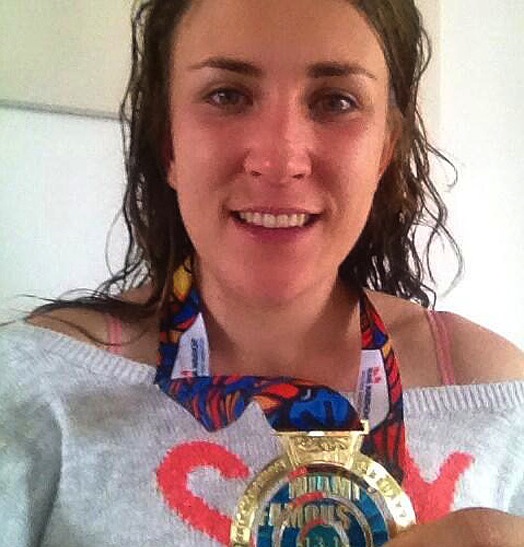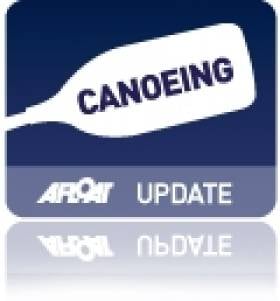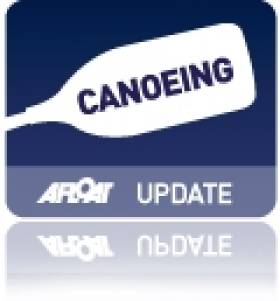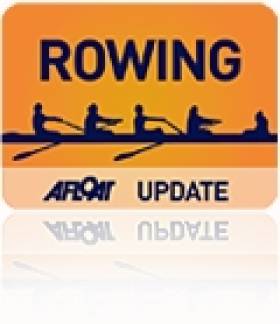Displaying items by tag: World Cup
#annalisemurphy – Ireland's Annalise Murphy finished her opening 2014 World Cup event in 32nd place from a fleet of 50 in Miami on Saturday. The reigning European champion's best result was an eighth scored in race four of seven (48, 35 42, 8, 29 and 25) in an otherwise lack lustre start to the new season, albeit in some pretty poor conditions. After the regatta ended the Irish London 2012 athlete went on to compete in Miami's Half Marathon today in a field of 25,000 runners, posting a picture of her running medal on her twitter account under the hashtag '#consolationmedal'. See below.
The fickle winds on Biscayne Bay proved no obstacle to some of Murphy's Olympic rivals, however, with local Paige Railey (USA) successfully defending her Miami title from last year with another stellar performance this week. Railey was the most consistent sailor from start to finish with a fleet series scoring line of 2-1-2-(12)-2-4. She had an 11 point lead over 2012 Olympic silver medalist Marit Bouwmeester (NED) heading into Saturday.
Bouwmeester comfortably won the medal race and Railey was second. They were first and second, respectively around each mark.
Despite a ninth place result in Saturday's race, Anne-Marie Rindom (DEN) captured the bronze.

Annalise with her Miami Half Marathon medal this afternoon
"I had some goals for how I wanted to sail the medal race and where I wanted to finish," said Railey. "I wasn't thinking about the – 'what if' - if I do this, I could lose the event. It was more about what I was going to work towards so I can keep progressing for Rio, and what we will face there."
Kinsale's Sorcha Ni Shuilleabhain also attended in Miami scoring 30 (46) 39 41 39 42 to place 45th overall.
Paul O'Donovan is Afloat Rower of the Year for 2013
# RowerOfTheYear: Paul O’Donovan is the Afloat Rower of the Year for 2013. The scholarship student at UCD raced to a bronze medal in the lightweight single sculls the World Under-23 Championships at Linz-Ottensheim in Austria in July. The previous month the 19-year-old had made his mark as a senior international when the reached the A Final at the World Cup Regatta at Dorney Lake, the Olympic venue, finishing sixth.
For these feats the Skibbereen man won the Afloat Rower of the Month Awards for June and July. He is a worthy recipient of the Afloat Rower of the Year Award for 2013.
Rower of the Year: The judging panel is made up of Liam Gorman, rowing correspondent of The Irish Times and David O'Brien, Editor of Afloat magazine.
Canoeist Banks Comes Close in Copenhagen
#CanoeMarathon2013: Malcolm Banks of Salmon Leap Canoe Club finished fifth in the K1 50 to 54 class at the Canoe Marathon Masters World Cup in Copenhagen in Denmark today. The Irishman got away with the leading group and was just 28 seconds off a medal at the finish. Banks was a Masters world champion in 2008.
Canoeist Heurteau Finishes Just Short of World Cup Final
#CanoeSlalomTacen: Ireland’s Ciarán Heurteau came within 1.24 seconds of qualifying for the final of the Canoe Slalom World Cup in Tacen in Slovenia this morning. In an exciting semi-final, the 26-year-old had a clear run in 107.22 seconds. This slotted him into eighth with eight competitors to go and he was eventually pushed into 15th. The 10th-placed qualifier clocked 105.98.
Eoin Rheinsich came down the course in a raw time of 108.19, but a touch on gate 13 cost him a two-second penalty. He finished 25th.
Canoe Slalom World Cup, Tacen, Slovenia – Day Two (Irish interest)
Men
K1 – Semi-Finals (Top 10 Qualify for Final): 15 C Heurteau 107.22, 25 E Rheinisch 110.19 (incl 2 sec pen)
Canoeists Heurteau and Rheinisch Both Make Semi-Finals
#CanoeSlalomTacen: Eoin Rheinisch and Ciarán Heurteau both qualified for the semi-finals of the men's K1 at the canoe slalom World Cup at Tacen in Slovenia today. Heurteau clocked an excellent time of 100.02 seconds with no penalties in his second run this afternoon. The French-born Irishman was under pressure as he had not guaranteed qualification with his first run.
Rheinisch did not compete in the second run as his first-run time of 102.21 had proved sufficient to qualify him to tomorrow’s semi-finals.
Hannah Craig did not qualify in the women's K1.
Canoe Slalom World Cup, Tacen, Slovenia – Day One (Irish interest)
Men
K1 – Heats (Top 40 Qualify): 9 C Heurteau 100.02 seconds (2nd run); 25 E Rheinisch 102.21 (1st run); 67 P Hynes 118.28 (2nd run; incl. 6 sec pen)
Women
K1 - Heats (Top 30 Qualify); 37 H Craig 170.88 (2nd run; incl 52 sec pen)
Ireland Canoeist Rheinisch Starts Well in Tacen World Cup
#CanoeSlalomTacen: Eoin Rheinisch started well at the Canoe Slalom World Cup in Tacen this morning. The Ireland paddler had a clear first run in a time of 102.21, placing him fourth in the K1 competition at this very early stage. Ciarán Heurteau was judged to have had a touch at gate four, adding a two-second penatly to his time of 104.77, and leaving him down the rankings. Patrick Hynes had a run of 123.17, including 10 seconds in penalties. The second run is due later today.
Heurteau Sole Irish Qualifier at Augsburg World Cup
# CANOE SLALOM WORLD CUP: Ciaran Heurteau was Ireland’s sole qualifier for the semi-finals on the first day of the canoe slalom World Cup in Augsburg, Germany. Heurteau, who has an Irish mother but was brought up near Paris, secured his place with his first run, and finished 23rd of the 40 qualifiers on a difficult course. Eoin Rheinisch placed 49th, missing a semi-final for the second successive World Cup. He also missed out in Cardiff.
Liam Jegou, who is just 17, did well but was disappointed with placing 44th in the men’s C1. Hannah Craig fell ill and did not compete in the women’s K1.
Canoe Slalom World Cup, Augsburg, Germany, Day One (Irish interest)
Men
K1 – Heats (First 40 Qualify for Semi-Finals): 1 Slovenia (P Kauzer) 98.22 secs; 23 C Heurteau 104.42 (incl 2 sec pen; 1st run); 49 E Rheinisch 107.52 (2nd run); 61 P Hynes 114.76 (2nd Run);
C1 – Heats (First 20 Qualify): 44 L Jegou 118.32 (incl 4 sec pen; 2nd run).
Women
K1 – Heats: H Craig did not start.
Kennedy and Dukarska Finish Sixth at World Cup Regatta
# ROWING WORLD CUP: Ireland’s new double scull of Leonora Kennedy and Monika Dukarska finished sixth at the World Cup regatta at Dorney Lake. The race was notable for the boat-stopping crab which China suffered at 1750 metres – only to recover and take a bronze medal. Britain won and Denmark were second. Kennedy and Dukarska had not started particularly well, but they recovered well and were up with the field until the middle stages.
World Cup Regatta, Dorney Lake, Day Three (Irish interest)
Men
Lightweight Single Sculls – A Final: 1 Portugal (P Fraga) 6:57.02, 2 Denmark One (S Jensen) 6:59.80, 3 Denmark Two (A Bendtsen) 7:00.24; 4 New Zealand 7:00.69, 5 Germany Two 7:04.66, 6 Ireland (P O’Donovan) 7:06.69.
Lightweight Double Sculls – A Final: 2 Britain (R Chambers, P Chambers)
Single Sculls – A Final: 2 Britain (A Campbell)
Women
Double Sculls – A Final: 1 Britain (F Houghton, V Meyer-Laker) 6:52.60, 2 Denmark (M Petersen, L Jakobsen) 6:53.41, 3 China (D Xu, F Pan) 6:57.81; 4 Germany 6:58.11, 5 Finland 7:01.32, 6 Ireland (M Dukarska, L Kennedy) 7:06.79.
Lightweight Single Sculls – A Final: 1 Austria (M Taupe-Traer) 7:36.62, 2 Germany (L Pless) 7:44.98, 3 Brazil (F Beltrame) 7:46.46; 4 Britain 7:47.40, 5 Ireland (C Lambe) 7:55.06, 6 Hong Kong 7:58.78.
Medals Slip Out of Reach of Lambe and O'Donovan at World Cup
# ROWING WORLD CUP: Ireland’s Claire Lambe finished fifth and Paul O’Donovan sixth in their lightweight single sculls finals this morning at the World Cup regatta at Dorney Lake. In a fast race, O’Donovan stayed in contention for bronze until the closing stages: Pedro Fraga of Portugal won, with Steffen Jensen second. His fellow Dane Andrej Bendtsen made a late charge to deny Duncan Grant of New Zealand bronze.
Lambe’s race belonged to Michaela Taupe-Traer (38). The experienced Austrian took gold ahead of Leonie Pless of Germany, with Brazil’s Fabiana Beltrame making heavy weather of taking bronze despite having the favoured lane six. The lanes had been reallocated because of winds. Lambe and Ruth Walczak of Britain had disputed third with Beltrame through the middle stages of the race.
World Cup Regatta, Dorney Lake, Day Three (Irish interest)
Men
Lightweight Single Sculls – A Final: 1 Portugal (P Fraga) 6:57.02, 2 Denmark One (S Jensen) 6:59.80, 3 Denmark Two (A Bendtsen) 7:00.24; 4 New Zealand 7:00.69, 5 Germany Two 7:04.66, 6 Ireland (P O’Donovan) 7:06.69.
Women
Lightweight Single Sculls – A Final: 1 Austria (M Taupe-Traer) 7:36.62, 2 Germany (L Pless) 7:44.98, 3 Brazil (F Beltrame) 7:46.46; 4 Britain 7:47.40, 5 Ireland (C Lambe) 7:55.06, 6 Hong Kong 7:58.78.
# ROWING WORLD CUP: Paul O’Donovan continued his remarkable run at the World Cup regatta at Dorney Lake when he finished second in his Semi-Final of the lightweight single sculls this morning and qualified for tomorrow’s A Final.
The 19-year-old UCD scholarship student did not have a very fast start – that fell to Pedro Fraga of Portugal, who blasted away from the field, led all the way and won well. O’Donovan and Andrej Bendtsen of Denmark fought it out for second, with the young Irishman winning the battle before the line.
Ireland’s Katie O’Brien and Keith Connolly finished sixth in the Trunk and Arms mixed double sculls and Tom Kelly was second in the B Final of the Arms and Shoulders single sculls.
World Cup Regatta, Dorney Lake, Day Two (Irish interest)
Men
Lightweight Single Sculls – A/B Semi-Final One (First Three to A Final; rest to B Final): 1 Portugal (P Fraga) 7:21.43, 2 Ireland (P O’Donovan) 7:24.38, 3 Denmark Two (A Bendtsen) 7:25.66; 4 United States 7:36.40, 5 Denmark Three 8:06.62; Brazil did not start.
Trunk and Arms Mixed Double Sculls – A Final: 6 Ireland (K O’Brien, K Connolly) 5:18.84.
Arms and Shoulders Single Sculls – B Final (Places 7 and 8): 2 Ireland (T Kelly) 7:19.08.





































































